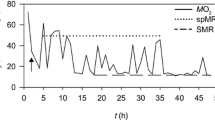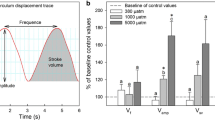Abstract
The influence of ambient calcium, bicarbonate and chloride levels on acid-base regulation was investigated in rainbow trout acclimated and exposed to hypercapnia in five different water types. In soft water (low [Ca++] and [HCO3 −]), compensation of the respiratory acidosis was slow and incomplete within 72h. High ambient [HCO3 −] clearly improved extracellular HCO3 − accumulation, and pH recovery was accomplished within 24h. This may result from stimulation of branchial HCO3 − (influx)/Cl− (outflux) exchange. Elevation of ambient [Cl−] had a small, positive effect on pH compensation. High ambient [Ca++] improved the degree of pH compensation. Plasma [HCO3 −] and [Cl−] showed an inverse 1:1 relationship in all acclimation groups, revealing an ubiquitous chloride-mediated acid-base regulation. Ventilation activity was increased by hypercapnia and only returned to control values in hard water (high [HCO3 −]and [Ca++]). During progressive hypercapnia (up to 3% CO2), hard water acclimated fish obtained significantly higher plasma [HC03 −] (51.2 mM) than fish acclimated to low [Ca++]/high [HCO3 −] (44.7 mM). This suggests an additive effect of ambient Ca++ on plasma HCO3 − accumulation. At levels of CO2 above 1%, some mortality was induced in low [Ca++]/high [HCO3 −] water. Dying fish could be distinguished from surviving fish by an excessive Cl−loss and increasing extracellular anion gap.
Similar content being viewed by others
References cited
Borch, K., Jensen, F.B. and Andersen, B.B. 1993. Cardiac activity, ventilation rate and acid-base regulation in rainbow trout exposed to hypoxia and combined hypoxia and hypercapnia. Fish Physiol. Biochem. 12: 101–110.
Boutilier, R.G., Heming, T.A. and Iwama, G.K. 1984. Appendix: Physicochemical parameters for use in fish respiratory physiology.In Fish Physiology. Vol. XA, pp. 403–430. Edited by W.S. Hoar and D.J. Randall. Academic Press, New York.
Burtin, B. and Massabuau. J.C. 1988. Switch from metabolic to ventilatory compensation of extracellular pH in crayfish. J. Exp. Biol. 137: 411–420.
Börjeson, H. 1977. Effects of hypercapnia on the buffer capacity and haematological values inSalmo salar (L.). J. Fish Biol. 11: 133–142.
Cameron, J.N. 1971. A rapid method for determination of total carbon dioxide in small blood samples. J. Appl. Physiol. 31: 632–634.
Cameron, J.N. and Iwama, G.K. 1987. Compensation of progressive hypercapnia in channel catfish and blue crabs. J. Exp. Biol. 133: 183–197.
Claiborne, J.B. and Heisler, N. 1984. Acid-base regulation in the carp (Cyprinus carpio) during and after exposure to environmental hypercapnia. J. Exp. Biol. 108: 25–43.
Claiborne, J.B. and Heisler, N. 1984. Acid-base regulation and ion transfer in the carp (Cyprinus carpio): pH compensation during graded long- and short-term environmental hypercapnia, and the effect of bicarbonate infusion. J. Exp. Biol. 126: 41–61.
Dimberg, K. 1988. High blood CO2 levels in rainbow trout exposed to hypercapnia in bicarbonate-rich hard freshwater — methodological verification. J. Exp. Biol. 134: 463–466.
Dimberg, K. and Höglund, L.B. 1987. Carbonic anhydrase activity in the blood and the gills of rainbow trout during long-tern hypercapnia in hard, bicarbonate-rich freshwater. J. Comp Physiol. B. 157: 405–412.
Goss, G.G., Laurent, P. and Perry, S.F. 1992. Evidence for a mot phological component in acid-base regulation during environmental hypercapnia in the brown bullhead (Ictalurus nebulosus). Cell Tiss. Res. 268: 539–552.
Goss, G.G. and Perry, S.F. 1993. Physiological and morphological regulation of acid-base status during hypercapnia in rainbow trout (Oncorhynchus mykiss). Can. J. Zool. 71: 1673–1680.
Heisler, N. 1984. Acid-base regulation in fishes.In Fish Physiology. Vol. XA, pp. 315–401. Edited by W.S. Hoar and D.J. Randall. Academic Press, New York.
Heisler, N. 1986. Acid-base regulation in fishes.In Acid-Base Regulation in Animals. pp. 309–356. Edited by N. Heisler Elsevier Science Publishers, Amsterdam.
Heisler, N. and Neumann, P. 1977. Influence of sea water pH upon bicarbonate uptake induced by hypercapnia in an elasmobranch (Scyliorhinus stellaris). Pflügers Arch. 368: Suppl., R19.
Heisler, N., Toews, D. and Holeton, G. 1988. Regulation of ventilation and acid-base status in the elasmobranchScyliorhinus stellaris during hyperoxia-induced hypercapnia. Respir. Physiol. 71: 227–246.
Heisler, N., Weitz, H. and Weitz, A.M. 1976. Hypercapnia and resultant bicarbonate transfer processes in an elasmobranch fish. Bull. Eur. Physiopathol. Respir. 12: 77–85.
Hyde, D.A. and Perry, S.F. 1989. Differential approaches to blood acid-base regulation during exposure to prolonged hypercapnia in two freshwater teleost: The rainbow trout (Salmo gairdneri) and the American eel (Anguilla rostrata). Physiol. Zool. 62: 1164–1186.
Iwama, G.K. and Heisler, N. 1991. Effects of environmental water salinity on acid-base regulation during environmental hypercapnia in the rainbow trout (Oncorhynchus mykiss). J. Exp. Biol. 158: 1–18.
Janssen, R.G. and Randall, D.J. 1975. The effects of changes in pH and PCO 2 in blood and water on breathing in rainbow trout (Salmo gairdneri). Respir. Physiol. 25: 235–245.
Jensen, F.B. 1988. Acid-base regulation and blood gas transport in freshwater teleosts. Environmental dependence and adaptation. Dr. Scient. thesis, Odense University.
Jensen, F.B. and Weber, R.E. 1982. Respiratory properties of tench blood and hemoglobin. Adaptation to hypoxic-hypercapnic water. Mol. Physiol. 2: 235–250.
Jensen, F.B. and Weber, R.E. 1985. Kinetics of the acclimational responses of tench to combined hypoxia and hypercapnia. II. Extra- and intracellular acid-base status in the blood. J. Comp. Physiol. B. 156: 205–211.
McDonald, D.G. 1983. The effects of H+ upon the gills of freshwater fish. Can. J. Zool. 61: 691–703.
Perry, S.F. 1982. The regulation of hypercapnic acidosis in two salmonids, the freshwater trout (Salmo gairdneri) and the seawater salmon (Oncorhynchus kisutch). Mar. Behav. Physiol. 9: 73–79.
Perry, S.F. and Laurent, P. 1993. Environmental effects on fish gill structure and function.In Fish Ecophysiology. pp. 231–264. Edited by J.C. Rankin and F.B. Jensen. Chapman & Hall, London.
Perry, S.F., Malone, S. and Ewing, D. 1987. Hypercapnic acidosis in the rainbow trout,Salmo gairdneri. I. Branchial ionic fluxes and blood acid-base status. Can. J. Zool. 65: 888–895.
Perry, S.F. and Wood, C.M. 1989. Control and coordination of gas transfer in fishes. Can. J. Zool. 67: 2961–2970.
Randall, D.J., Heisler, N. and Drees, F. 1976. Ventilatory response to hypercapnia in the larger spotted dogfishScyliorhinus stellaris. Am. J. Physiol. 230: 590–594.
Soivio, A., Nyholm, K. and Westman, K. 1975. A technique for repeated sampling of the blood of individual resting fish. J. Exp. Biol. 63: 207–217.
Smith, F.M. and Jones, D.R. 1982. The effects of changes in blood oxygen carrying capacity on ventilation volume in the rainbow trout (Salmo gairdneri). J. Exp. Biol. 97: 325–334.
Thomas, S., Fievet, B., Barthelemy, L. and Peyraud, C. 1983. Comparison of the effects of exogenous and endogenous hypercapnia on ventilation and oxygen uptake in the rainbow trout (Salmo gairdneri R.). J. Comp. Physiol. 151: 185–190.
Toews, D.P., Holeton, G.F. and Heisler, N. 1983. Regulation of the acid-base status during environmental hypercapnia in the marine teleost fishConger conger. J. Exp. Biol. 107: 9–20.
Truchot, J.-P. 1987. Comparative Aspects of Extracellular Acid-Base Balance. Springer, Berlin.
Vermette, M.G. and Perry, S.F. 1988. Adrenergic involvement in blood oxygen transport and acid-base balance during hypercapnic acidosis in the rainbow trout,Salmo gairdneri. J. Comp. Physiol. B. 158: 107–115.
Wood, C.M., Turner, J.D. and Graham, M.S. 1983. Why do fish die after severe exercise? J. Fish Biol. 22: 189–201.
Author information
Authors and Affiliations
Rights and permissions
About this article
Cite this article
Larsen, B.K., Jensen, F.B. Influence of ionic composition on acid-base regulation in rainbow trout (Oncorhynchus mykiss) exposed to environmental hypercapnia. Fish Physiol Biochem 16, 157–170 (1997). https://doi.org/10.1007/BF00004672
Accepted:
Issue Date:
DOI: https://doi.org/10.1007/BF00004672




